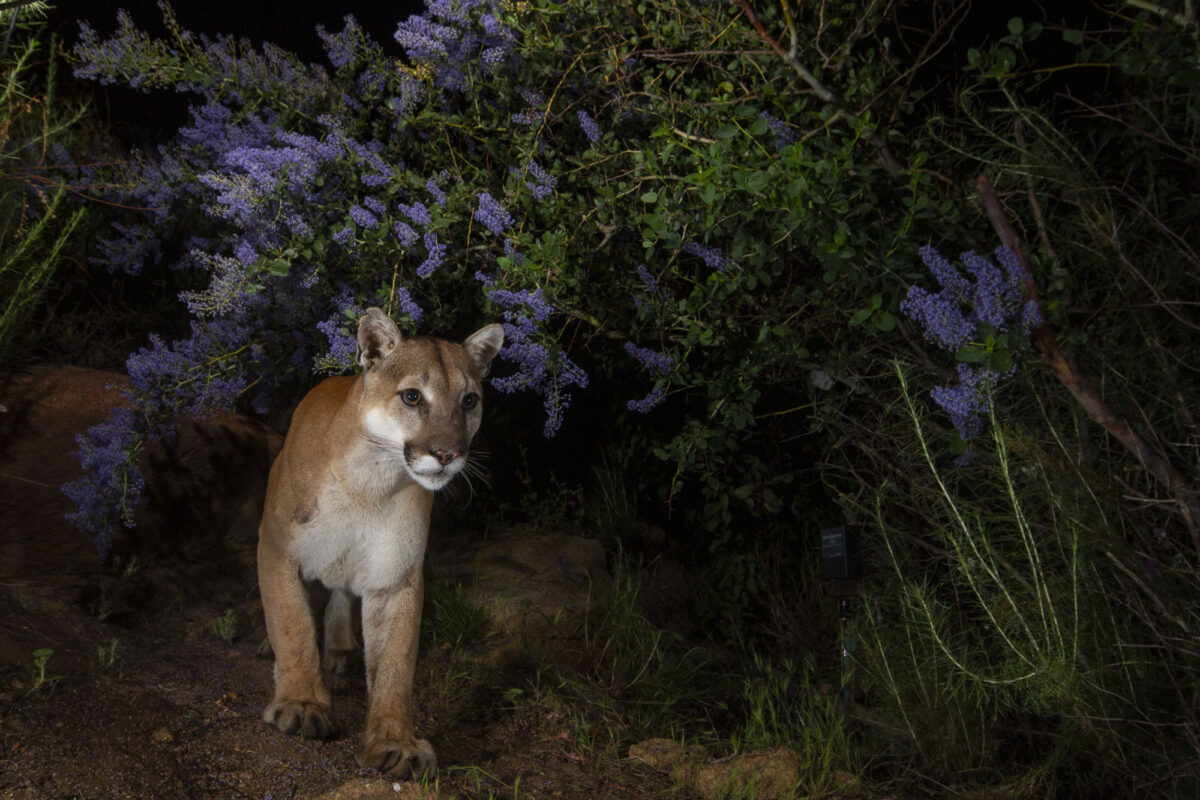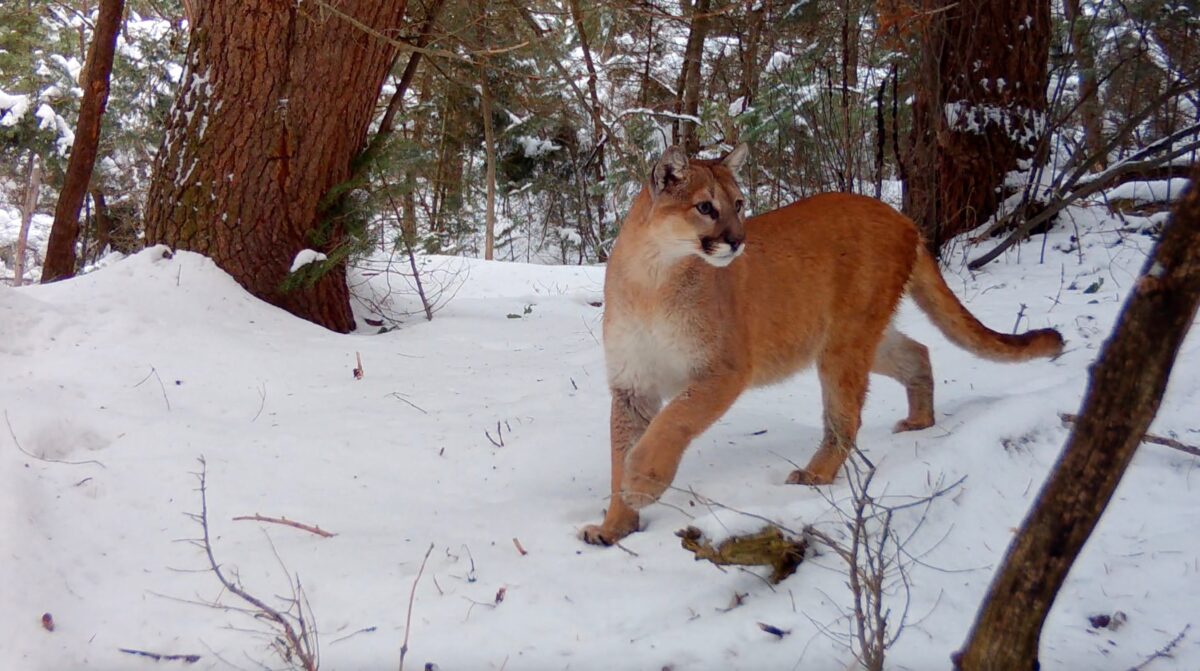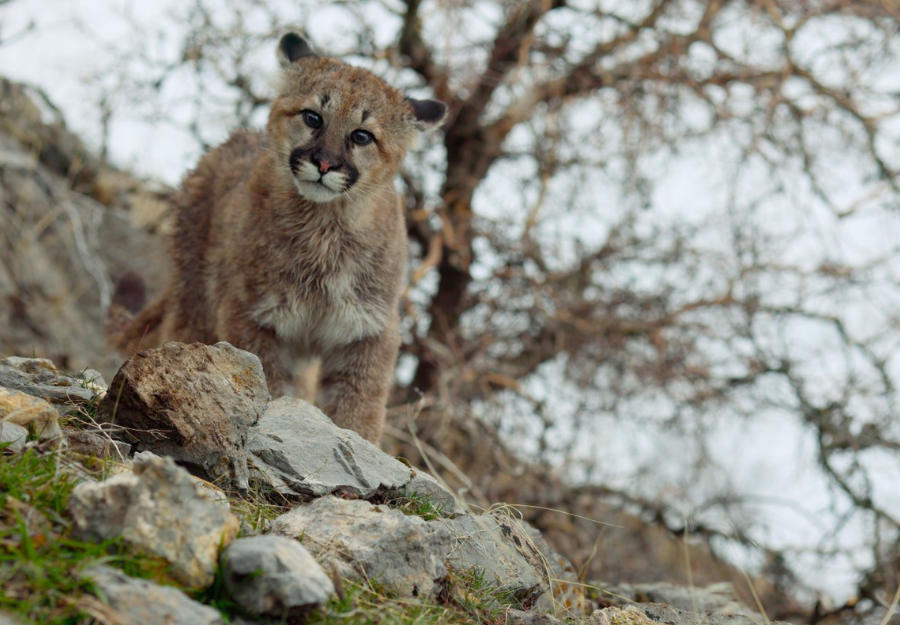A Northern California family put coexistence principles into practice when a mountain lion appeared
By Gowan Batist, Coexistence Coordinator
One key service the Mountain Lion Foundation offers to the community is support and resources for people living in proximity to cougars. We help people secure their barnyards and protect their pets, answer questions about mountain lion behavior and ecology, and provide practical advice on coexisting peacefully with wildlife.
As the Mountain Lion Foundation’s Coexistence Coordinator and a sheep rancher, I am equally committed to protecting the well-being of mountain lions and the domestic animals that people raise. I believe strongly that a healthy stable population of mountain lions is the best asset a ranch can have, far safer than a harassed and desperate population of lions. This belief is based on the wealth of research that shows the positive impacts of cougars on the ecosystem (such as Ripple and Beschta, 2006), as well as my own working experience on the landscape.
In my role with the Mountain Lion Foundation, I split my time between educating and providing tools for ranchers and homesteaders and educating mountain lions. I tackle that second part by implementing strategies that teach mountain lions to avoid humans and domestic animals before they learn a much harder, or even fatal lesson.
A lion at the gate
One morning, as I woke up in the dark on my ranch, lit the woodstove, and sat down to work, I found I had a message from a concerned family in Northern California in my inbox.
A large mountain lion had been seen at their place out in the country. He’d been near their gate every night for several nights. A member of the household who arrives home from work between midnight and two am had seen him, and he had seen her. He’d levelly met her gaze from where he lounged by the edge of their woods. Understandably, she was hesitant to get out of her car to open and shut the gate. The family was also concerned about their chickens and dog, and wondering why a large lion would be camped out on their property.
The unknown is the source of most fear. This family was familiar with life in the country, but this lion was behaving in a way they didn’t understand — not aggressively, but also not particularly impressed by their presence. Knowing that lions have large territories, they wondered why this one was hanging out in one spot.
They wanted practical help, insights into what was happening, and safety advice. They were worried their neighbors would see the lion and shoot on sight, but also worried that the nonchalant behavior could be the precursor to a threat.
While the topic of wildlife coexistence can be a divisive one in the agricultural community, I am consistently impressed by the people who reach out to the Mountain Lion Foundation for help. They are responsible, proactive, and concerned people. If the call comes after the loss of a pet or beloved goat, they are bereaved. That they reach out shows courage, curiosity, and engagement — all traits well-suited to practicing coexistence.
When I spoke to the owner of the homestead, I asked specific diagnostic questions about the condition of the mountain lion to determine the response needed.
-
-
- Were the lion’s backbone or ribs showing?
- Was its fur patchy?
- Were there any discernable wounds?
- Had anyone had seen the lion walk? If so, was the gait normal?
-
These questions help me to determine if the lion was possibly suffering from rodenticide poisoning or disease, could have been hit by a car, or could be an orphaned teenager, which are often full-sized physically, but, like human teenagers, are still reliant on mom to survive.
Nope, this lion was fat and glossy. After being shouted at and having the car horn blown, it had unconcernedly sauntered away without missing a step. And this lion was also not a nursing mother of young cubs. As they noted, “he had a big ‘ol set of balls on him!”
Having ruled out worst-case scenarios, we moved on to discussing the landscape around the house and their domestic animals. They have a large American Bulldog, two outdoor cats, and a large flock of poultry. I asked about the coop and poultry fencing. The poultry free-ranged during the day, but the lion was hanging out on the other side of the property, and they weren’t missing any birds. I advised them to keep the chickens inside their covered run for the next few days while we worked out what was going on, and to keep the cats in a barn or garage. I told them it was precedented for a large dog to be attacked, but generally, a healthy mountain lion won’t take that risk. In the recent tragic case of a Malinois killed by a mountain lion, the lion was in desperate physical condition. Generally, an obligate carnivore is a cautious creature, as even a small wound can render it unable to hunt and subject to starvation. Mountain lions will avoid a fight if at all possible unless their imminent starvation poses a greater risk in their mind than a dog’s teeth.
The family had already taken the step of purchasing an automatic gate opener to solve the immediate anxiety surrounding getting out of the car in the middle of the night within sight of a big male mountain lion, which was a great idea and a long-term convenience and safety feature. I advised that they also get a marine air horn that day for everyone living there, to blow if they saw the lion too close for comfort. Though it might be tempting to enjoy watching an elusive native wildlife species, something few lifelong conservationists have ever experienced, it’s not good for a lion to get comfortable seeing and hearing humans.
On the night after we talked, the lion was lounging by the front gate again, so I decided to make a site visit to the property.
Their massive, gregarious American Bulldog, built like an enthusiastic refrigerator, barreled into me immediately upon my arrival. Given that the lion in question was healthy, I didn’t think this bulldog was in imminent danger of becoming prey, but I advised his owners not to let him loose at night while the lion was around and to keep him in their lit yard when taking him out.
Their chicken coop was sturdy, well-built and clean with no food left outside to attract small animals like possums that a lion might choose to prey upon.
Noting the plentiful deer habitat on their property, I asked about the local deer and was told that they saw deer all the time. Deer bedded down in the woods, grazed the pastures, nibbled apples from the trees, and often sauntered down the middle of the driveway. We walked the area where the mountain lion had been seen most often and found his wide, shallow lounging spots and observed how incautious he was being about his presence; he was using the existing deer trails but wasn’t bothering to be stealthy.
They asked why he was hanging out in the middle of the night when mountain lions are supposed to be most active at dusk and dawn. People often think of lions as nocturnal, but the reality is that they can be seen anytime at all, including in the middle of the day. They may shift to be more nocturnal to avoid humans when in proximity to us, but just as we get up in the middle of the night and putter around our houses sometimes, they do too. If they are otherwise healthy in appearance and behaving normally, there’s nothing inherently alarming about a lion out at 2 am or 2 pm.
By this point, I had a strong hypothesis.
I asked more questions about the deer. Did they typically see one group, or several? How many in the groups? Had they seen them lately?
They told me that they typically saw a doe with two nearly grown fawns. The last time the group was spotted, they had seen only two, not three. And they had been across the road, staying far from their property.
I told them that I was almost certain they had a deer cache in their woods, near where the lion was lounging at night. Mountain lions cache their kills in piles of grass, sticks and leaves, unlike bears who will often bury kills in dirt. There was abundant brush to conceal a deer kill, right next to the lion’s lounge.
Our next order of business was installing several scare devices around their home and on the newly automatic gate post to create a buffer of comfort around the human-occupied areas and chicken coops. We gave the homeowner solar flashing motion lights, a motion-activated sprinkler with a siren alarm (picture a squirt bottle for a kitty, scaled up for a wild cat) for the area outside the fence where the dog went potty at night, to make sure the dog and lion wouldn’t come into contact even accidentally, and we gave them personal air horns to keep with them. We also loaned them a game camera, pointed at the area the lion had been occupying, and a Foxlight, to use at the chicken coop if they started to see interest in their poultry from their guest lion.
After the family hadn’t seen the lion for several days, I made a return visit. They reported having seen more other animals than usual in their yard, including a bobcat. I shared a story about the bobcat I’d seen following a lion on one of my game cameras. When I followed the tracks, the little cat had even put their paws directly on top of the tracks of the big cat.
By now, I explained, the lion had likely moved on. It typically takes a lion 5 to 10 days to eat a deer depending on the size of the deer, the size of the lion, and the climate. Now that the carcass wasn’t defended, they could expect to see scavengers, like the bobcat, for a little while. The deterrents we’d installed would also discourage those scavengers from coming to the house. The owner remarked that it had seemed odd that there hadn’t been vultures when there was a dead deer, as there was usually a crowd of them surrounding a roadkill deer. That’s likely why the mountain lion was sticking so close, I ventured, adding a prediction that they would start seeing them now.
Then, right on cue, two big buzzards started a downward spiral from the sky, landing in the thick brush right where the lion had been hanging out.
(Thank you, buzzards, for one of the coolest moments of my professional life!)
We decided to leave the game camera up for a week to see what other scavengers came around. The lion was never seen in their yard again, and their pets and livestock remained safe throughout his time in their yard, and the scavenging period afterwards.
Case-closed
Demystifying the unknown is a crucial element of the Mountain Lion Foundation’s coexistence work.
In all likelihood, this family will never have a deer cache in their driveway again, since mountain lions have a territorial range of up to thousands of acres, and generally an area that supports one lion has to support 360 deer. Few of us will get to see the kind of natural behavior play out that they witnessed from front-row seats. I understand this was a dubious privilege, and it’s normal and appropriate to be cautious around a large wild carnivore. In the rare opportunity that they had, this family made a choice to seek information and tools, rather than resorting to fear. They didn’t haze the lion and drive him away from the food source he had gone to great trouble to acquire, which could have made him more likely to take a chance on someone else’s livestock. That is coexistence in action.
Practicing coexistence is not only a gift to wildlife and the ecosystems that mountain lions help create and maintain, but a gift to our families and neighbors. Somewhere out there, a healthy mountain lion is able to kill and eat his natural prey, leaving pets and chickens untouched. He’s learned horns are annoying and people are best avoided, and he lived to put that knowledge to use as a responsible member of the community. This family protected themselves, their pets and their poultry, but they also protected him.
I’m grateful for this family and happy that I am able to do the work I do thanks to the generosity and foresight of Mountain Lion Foundation supporters.



 Facebook
Facebook Twitter
Twitter Send Email
Send Email


